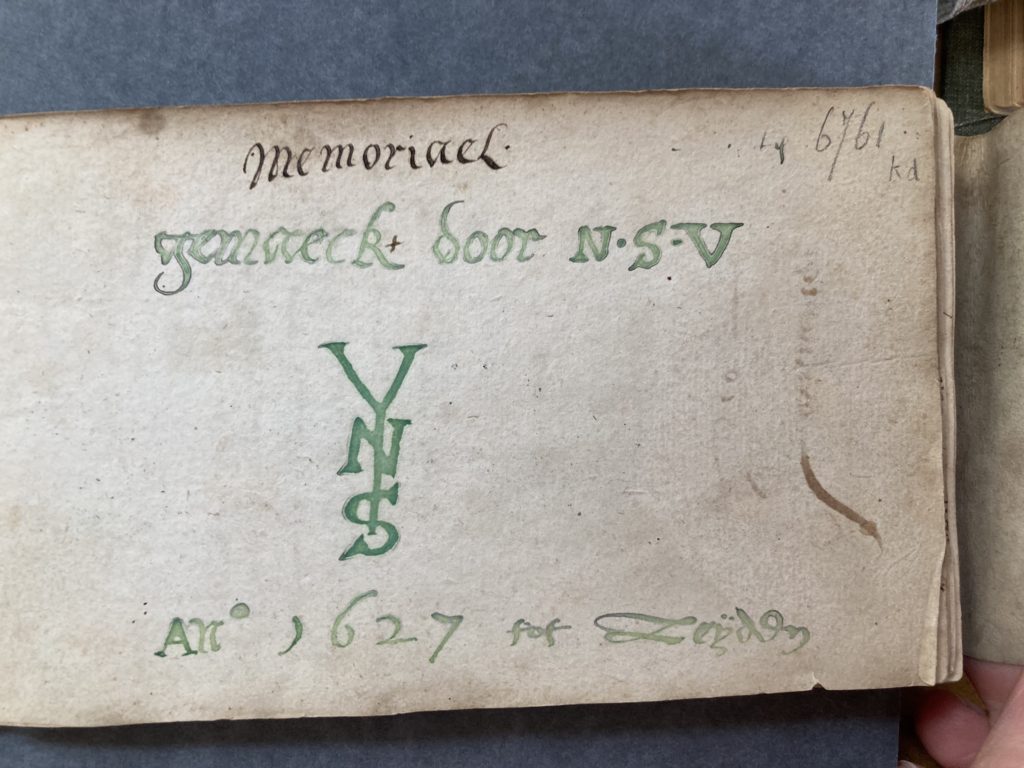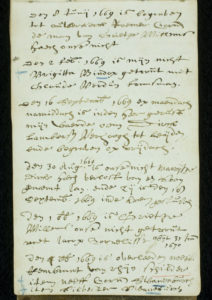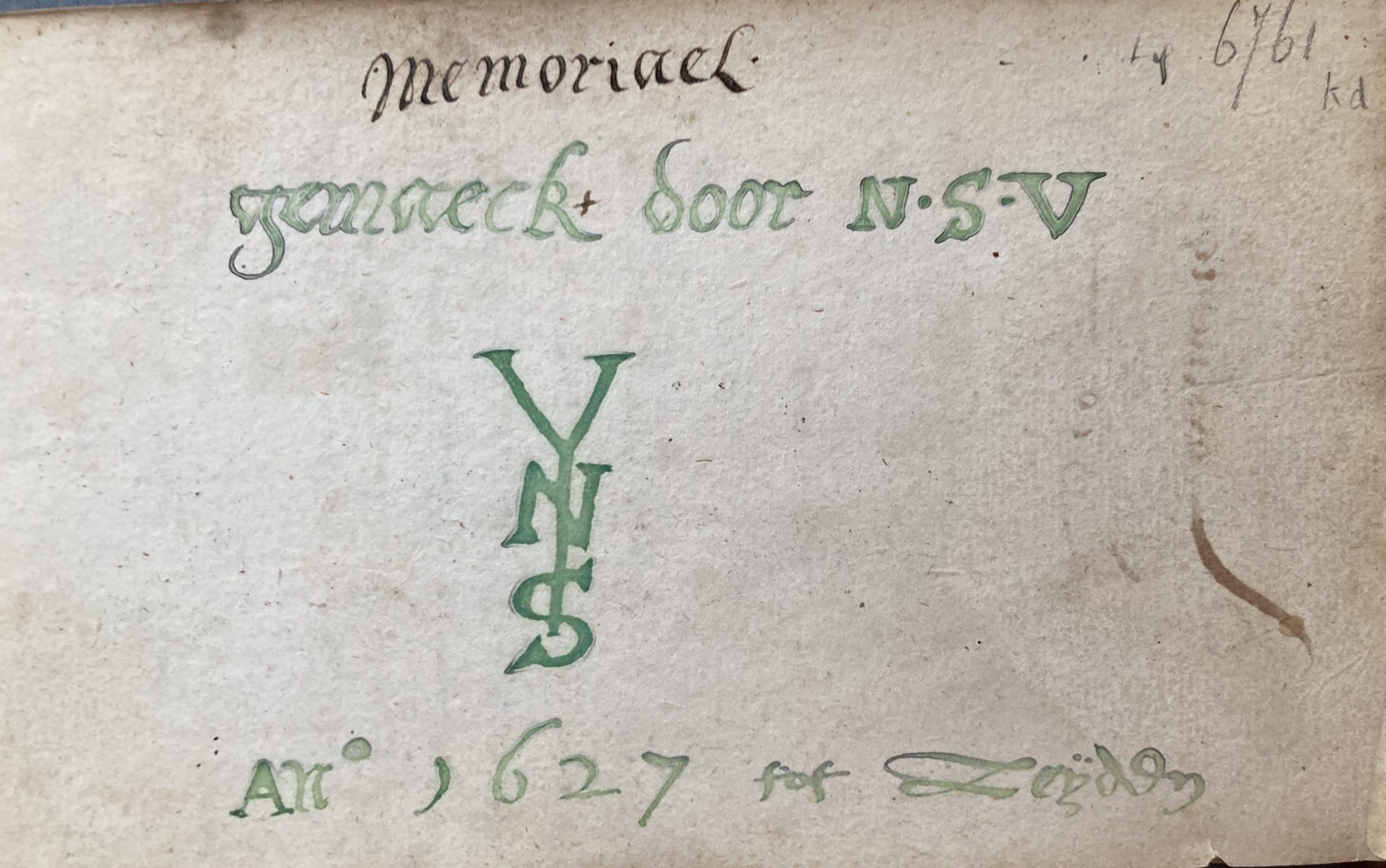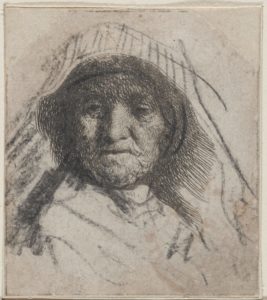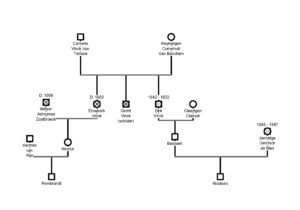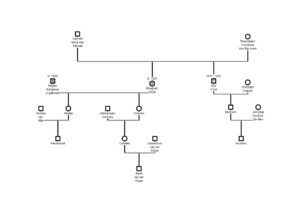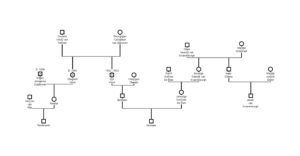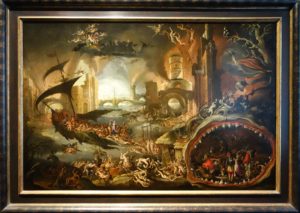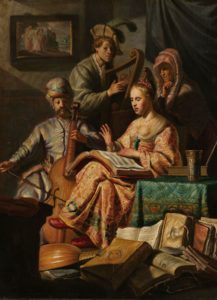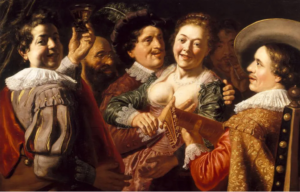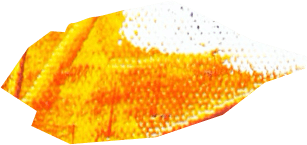The most basic facts of Rembrandt’s life, his birth and death, are sparsely documented. In 1641, the Leiden city historian Jan Orlers listed the artist’s birthdate as 15 July 1606. Lacking a baptismal record, most scholars have taken Orlers at his word.1 The only source for Rembrandt’s date of death is the Memoriael, or family record book, kept by Nicolaes Sebastiaensz Vinck (1608-1679), an apothecary who grew up in Leiden and moved to Amsterdam a few years before Rembrandt did (fig. 1). In a list of events from 1669, Vinck writes that his neef (relative or cousin), ‘Rembrandt van Rhyn, painter’, died on 4 October (fig. 2). The ‘4’ is corrected from a ‘5’, suggesting that Vinck received the information at some remove from the event, but the date aligns with burial records indicating that Rembrandt was interred in the Westerkerk in Amsterdam on 8 October 1669.2 A partial transcription of Vinck’s Memoriael was published in 1906 but failed to catch the attention of Rembrandt scholars.3 In 1956, Dirk Rühl cited Vinck’s account in an article on heraldry and the Van Rijn family.4 When Walter Strauss compiled The Rembrandt Documents in 1979, he repeated Rühl’s brief citation and dismissed Vinck as a ‘distant relative’.5 There the matter rested until 2022, when research for a new publication contextualizing Rembrandt’s death prompted us to seek out Vinck’s Memoriael for a first-hand look. We found it in the archives of Erfgoed Leiden en Omstreken (not in the Centraal Bureau voor Genealogie in The Hague, as stated by Rühl and Strauss).6 As it turns out, this family chronicle sheds light not only on Rembrandt’s death, but also on his childhood in Leiden. The clue lies in two entries that follow Vinck’s reference to Rembrandt: den 4 8b[er] is overleeden neeff Rembrant van Rhijn schilder item neeff Corn[elis] Swanenburch item Silvester van Swaneburch Remarkably, these notes have not been examined until now. A similar chronicle written by Willem Jacobsz. van Heemskerk (1613-1692), husband of Maria van Swanenburgh (1616-1680), confirms that ‘Silvester van Swaneburch’ can be identified as the son born in Naples in 1610 to the Leiden painter Jacob van Swanenburgh (1571-1638) and his Neapolitan wife, Margaretha Cardone (d. 1639). Vinck’s ‘neeff Corn[elis]’ must be Silvester’s second cousin, the eldest child of Jacob van Swanenburgh’s first cousin, Huygh Claesz van Swanenburgh, alias van Rossum (1578/79-1635), and Adriana Claesdr. van Leeuwen (d. 1640). Huygh was a cloth merchant, and Cornelis followed his father’s profession, becoming a staalmeester in 1641. Born the same year as Rembrandt, Cornelis was buried in Leiden on 7 October 1669. Silvester van Swanenburgh died soon after.7 This essay explores Rembrandt’s connections with the Vinck and Van Swanenburgh families and their implications for his life and career. Given the importance of family alliances in early modern Dutch society, we consider relations by marriage as well as by blood. Through this research, Nicolaes Vinck and Silvester van Swanenburgh gain substance as persons in Rembrandt’s social network. A key discovery is that if Silvester was related to Vinck, and hence to Rembrandt, so too was Silvester’s father: Jacob van Swanenburgh, Rembrandt’s first teacher.
|
Nicolaes Vinck and his Memoriael As noted on his title page (fig. 1), Vinck started the chronicle in Leiden in 1627. Milestones in the lives of several generations fill its small, densely packed pages. While some entries are brief, others convey vivid details. When a child is born, Vinck often records which older relative the child is named for and who stands as godparent. He describes painful deliveries, protracted illnesses, and difficult deaths. For instance, his neef Lambert Teunissen suffered for five days before dying on 23 May 1669; he had fallen off a wagon that then rolled over him.8 On a page for 1679, a line is drawn and new handwriting appears. Nicolaes’s eldest son Sebastiaen (1638–1717) writes that his father ‘Claes Vinck’ died between four and five in the morning of 14 November after ailing for several weeks. He was laid to rest in the Begijnkerk in Amsterdam beside his wife, Maria Dircks Haegen (1614-1678), who had died on 4 August 1678.9 Sebastiaen and other descendants continue to add data to the Memoriael until the mid-1760s. When Vinck turned the page of his notebook after listing the deaths of Rembrandt and the Van Swanenburghs, he recorded one of the few general reflections in his text: Anno 1669 was een jaer van groote sieckte ende sturven door veel Hollandsche steeden verscheyde gequalificeerde burgers principael tot Leyden daer allevier de burgemeesters overleeden. (‘1669 was a year heavy with disease, and in many cities in Holland various distinguished burghers died, especially in Leiden, where all four burgomasters passed away’.)10 The Van Heemskerk chronicle also mentions this epidemic and the deaths of many relatives during this period, including two within fifteen hours in October: Silvester and another cousin, Mr. Isaac van Swanenburgh (c. 1643-1669).11 Historical research has confirmed a widespread outbreak of an unspecified disease in 1669; Amsterdam was affected but Leiden was especially hard hit.12 It is unlikely that Rembrandt died from this epidemic; there are numerous indications that the artist continued painting and receiving visitors until his final days, suggesting that his death was quite sudden.13 |
Rembrandt’s mother, Neeltje (or Cornelia) Willemsdr. van Zuytbroeck (1568-1640), is often identified as the model who posed for numerous studies of elderly ladies by the young artist and his associates in Leiden (fig. 3).14 Neeltje’s family tree provides the connection to Nicolaes Vinck (fig. 4).15 Neeltje and Bastiaen Dircsz. Vinck (before 1581-1623), Nicolaes’s father, shared the same grandmother, Reymptgen (or Rijmpje / Rimigia) van Banchem (or Bancken) (c. 1510-1581/5).16 Strauss suggested that Rembrandt’s unusual first name was chosen to honor her.17 Reymptgen’s husband Cornelis van Tetrode (d. 1564) adopted his mother’s surname, Vinck. Their children included Rembrandt’s grandmother (Neeltje’s mother) Elisabeth Cornelisdr. [Van Tetrode] (1530-1603), Nicolaes Vinck’s grandfather Dirk Cornelisz. Vinck (1542-1632), who became a grain dealer, and Gerrit Cornelisz. Vinck (before 1544-after 1588), a painter and baker.18
In 1581, Rembrandt’s widowed great-grandmother Reymptgen was living with her son Dirck Cornelisz. Vinck and his wife in a house called ‘t Gulden Warcken (‘the Golden Hog’) on the Warmoesmarkt in Leiden. The census document records their household immediately before that of Rembrandt’s grandparents, Elisabeth Cornelisdr. and Willem van Zuytbroeck, a baker (d. 1609). Thus, Rembrandt’s mother Neeltje and Nicolaes Vinck’s father Bastiaen grew up next door to one another.19 Nicolaes was born on 14 December 1608, two and a half years after Rembrandt. It seems likely they knew each other as children.
Vinck tells us that on 16 May 1628, he moved to Amsterdam to join the apothecary practice of Roelof Ortsz Walsburch. On 20 April 1629, Walsburch and his wife drowned in the IJ.20 This tragic accident enabled Vinck to purchase their house and business, located on the Kalverstraat on the corner of the Watersteeg, close to the Begijnhof; he lived there for the rest of his life.21 On 10 May 1636, Vinck and Maria Dircks Haegen were married at the Begijnkerk; the renowned Catholic pastor Leonardus Marius (1588-1652) officiated.22 Other family members also joined the Catholic community in Amsterdam. Baptisms in the Begijnkerk are recorded, and several of the women became beguines, including Vinck’s sister Clara (1617-1657), who lived in the Begijnhof until her death.23 His brother Albert (1611-1683), a grocer and baker, married Maria Jansdr. Poef (d. 1654) in Amsterdam on 2 January 1642 and became a citizen (poorter) a few months later.24 In 1647, they buried their mother, Jannetje Gerritsdr. de Man (1585-1647), in the Begijnkerk.25 Like Nicolaes and his wife, Clara and Albert would also be buried there.26
Belonging to another branch of this family tree was the painter Karel van der Pluym (1625-1672) (fig. 5). Karel was the only child of Rembrandt’s cousin Cornelia Cornelisdr van Zuytbroeck (d. 1652); her father, Cornelis Willemsz. van Zuytbroeck (1566-1631), a baker, was Neeltje’s brother (thus, Rembrandt’s uncle).27 Karel’s father was Domenicus van der Pluym (d. 1661), a prosperous plumber and slater in Leiden. In the 1640s and 1650s, Karel produced history paintings and figure studies that follow Rembrandt’s example so closely that it seems clear he moved to Amsterdam to study with his cousin. He might have lodged with another uncle, Willem Jansz van der Pluym (d. 1675), whose inventory includes a portrait drawing of himself by Rembrandt. Other documents show that the families kept in touch. Karel gave up painting a few years after he returned to Leiden in 1648. He joined the city’s governing Council of Forty in 1664 and died a wealthy man. If Rembrandt and his son Titus had not predeceased him, they would have been among his beneficiaries.28 Although Nicolaes Vinck has been overlooked as a ‘distant relative’, his genealogical connection to Rembrandt was closer than that of Karel van der Pluym. His father, Bastiaen Dircksz. Vinck, and Rembrandt’s mother, Neeltje, were first cousins; Van der Pluym’s grandfather Cornelis was their second cousin. So far, however, there is no evidence that Rembrandt maintained a relationship with the Vincks as he apparently did with the Van der Pluyms. This might partly be explained by the fact that Vinck’s social network was largely Catholic. Yet, Nicolaes Vinck, his brother Albert, and Rembrandt were cousins, close in age and social status, who lived near each other as children and moved from Leiden to Amsterdam within a few years of each other. Profession offers another possible contact point: apothecaries often supplied painters with pigments.29 While Rembrandt developed close ties with another apothecary, Abraham Francen (1612-after 1678), their friendship may have been based on their shared passion for collecting, documented in Rembrandt’s etched portrait of Francen surrounded by his treasures (c. 1657).30 We do not know from whom Rembrandt purchased his painting materials. |
The connection between the Van Swanenburghs and the Vincks is found in Nicolaes’s mother, Jannetje Gerritsdr. de Man (fig. 6). She was the daughter of Gerrit Arentsz. de Man, a Catholic baker and zoutzieder (salt refiner), and Jacobge Claesdr. van Swanenburgh. This lineage adds another artist to the family tree: Gerrit was the brother of the landscape painter Jan Arentsz. de Man (d. 1625), named by Orlers as teacher to Jan van Goyen (1596-1656).31 Jacobge was the youngest sister of the painter and burgomaster Isaac Claesz. van Swanenburgh (1537-1614) and, hence, the aunt of Rembrandt’s instructor, Jacob van Swanenburgh.32 In the Leiden census of 1581 (before Jannetje was born), the couple De Man and their three children were recorded living on the Boterstraat, around the corner from the Vinck and Van Zuytbroeck families on the Warmoesmarkt, mentioned above.33 The involvement of these families in grain dealing, milling, and baking bound them together within the city’s economy. It is highly likely that they were in contact. As a child, Jannetje Gerritsdr. de Man may well have observed her older brother, Isaac van Swanenburgh, instructing her cousin Jacob in the art of painting. In 1591, Jacob left Leiden for adventures abroad. From 1596 to 1615, he resided in Naples, where he married and joined a community of Dutch and Flemish artists.34 The year after his father died, he returned to Leiden, and in 1618, he brought his wife to live there along with their son Silvester and two daughters. In Leiden, Jacob continued to produce the dramatic history paintings and scenes of hellfire and witchcraft that had brought him notoriety in Italy (fig. 7), but he also received commissions for decorative painting from the Stadholder’s court.35 In 1620, Rembrandt’s parents enrolled him in Leiden University, and it has recently been discovered that he renewed his registration in 1622.36 Nevertheless, as Orlers describes, he was determined to pursue a career in painting, and his parents chose Jacob van Swanenburgh as his first instructor. Perhaps Jannetje Gerritsdr. de Man played a role in establishing contact between Rembrandt’s parents and her cousin Jacob. Orlers states that Rembrandt spent three years in Jacob’s studio before going to Amsterdam to work for six months with Pieter Lastman (1583-1633).37 During these years (1622-25), Silvester van Swanenburgh would surely have encountered Rembrandt in the family home. Silvester resided on the Breestraat in Leiden until 1654, when he moved to Huis ter Lucht on the Donkersteeg.38 By 1637, he was established as a public notary, and in 1638 he is listed as a citizen (poorter) of Leiden and secretaris van het baljuwschap van Rijnland (Secretary of the Bailiwick of Rijnland). He still held that post when he was recorded on 12 October 1669 as sick in bed; he must have died shortly thereafter.39
Many authors have sought to explain why Rembrandt’s parents chose Jacob van Swanenburgh as his first teacher. There is little obvious connection between the two artists’ approaches to subject matter or style. Yet, this disparity is less concerning than it seems: from his initial instructor, Rembrandt would be expected to learn fundamental skills rather than a specific style, and many painters developed independently as they matured.40 Constantijn Huygens, not realizing that Rembrandt’s parents were prosperous, supposed they sought a local artist ‘whose fees were modest’, but this dismissive statement seems disingenuous when we realize that Jacob received court patronage and that Huygens’ own son, Constantijn the Younger, was tutored by Jacob’s cousin Johan and married into the family.41 The simplest explanation is lack of choice: in Leiden in the 1620s, only Jacob van Swanenburgh and Joris van Schooten (1587-1651) were painting historical subjects. Van Schooten, teacher of Rembrandt’s friend and rival Jan Lievens (1607-1674), was better known for portraiture.42 That said, the assumption that Rembrandt set out to be a history painter is challenged by the large number of genre scenes and tronies (figure studies) he created in his early years, together with Lievens and their associates. The iconographic fluidity of Rembrandt’s early work suggests that he aspired to an even higher goal: to be a ‘universal artist’, adept at all aspects of his craft.43 A case in point is the cryptic Musical Allegory (fig. 8), in which we recognize Rembrandt’s mother in the richly dressed old woman, while Lievens plays the harpist whose rude gesture signals a moralizing connotation for the scene.44 The inventiveness of Van Swanenburgh’s dramatic imagery must have caught Rembrandt’s interest, while techniques and anecdotes collected abroad would have dazzled an ambitious young artist who had never left his native city. All this may explain why Rembrandt was content to stay in Van Swanenburgh’s workshop for three years, but, as Orlers stated, the choice to send him there was made by his parents. As far as we know, they were not scholars or art collectors. One of their older sons took over the family business; another became a baker and grain dealer. Baking and milling were respectable professions that could lead to prosperity, but they were also practical trades, pursued by a network of families whose interests and connections were more local than global. Perhaps for Rembrandt’s parents, international cachet was all very well, but faith and family ties would have resonated more directly.45 Although Catholicism after 1618 became a political liability, Rembrandt’s mother, who came from a Catholic family, might have appreciated the fact that Jacob van Swanenburgh and his Italian wife were Catholic.46 We can now add the reassuring factor of a family relationship, through the Vincks, with the distinguished Van Swanenburgh clan. Rembrandt’s choice of profession seems less surprising when we realize there were already artists in the family. |
|
While our research sheds light on Rembrandt’s choice of teacher, it does not yet add evidence of Leiden patronage for him.47 In fact, several people in his network seem to have preferred the work of Lievens. Arnold Houbraken transcribed a poem published in 1662 by the Leiden author Dirk Traudenius, Op de gedootverfde beeldenis van de Heer Secretaris Silvester van Swanenburg door Johan Lievens (‘On the painted likeness of Mr. Secretary Silvester van Swanenburgh by Jan Lievens’). The text adopts a conventional trope praising the portrait as almost lifelike enough to speak.48 Lievens left Leiden in 1632, but he returned in 1639 for a commission to paint The Magnanimity of Scipio for the Leiden Town Hall. Completed in 1641, the painting was praised by Orlers, and the Leiden city fathers awarded Lievens the impressive sum of 1500 guilders and a gold medal.49 Perhaps it was in this context that Lievens painted Silvester to celebrate his role as Heer Secretaris.
Since Rembrandt and Lievens continued to share interests and patrons as they matured, Silvester’s portrait belongs by extension to Rembrandt’s milieu.50 Thus, it remains intriguing that Silvester chose Lievens and not Rembrandt. The same can be said for the Van Leeuwens, a prominent Leiden family with which the Van Swanenburghs and two of Rembrandt’s brothers were connected by marriage.51 In his recent study of the Leiden art market, Piet Bakker found 43 mentions of Lievens in 22 Leiden inventories, including a painting of ‘The Five Senses’ in the estate of the wealthy brewer Adriaen van Leeuwen (1641), husband of Jacob van Swanenburgh’s niece Maria (fig. 9). He found only 16 paintings by Rembrandt in 10 estates.52 Orlers stated that Jan van der Graft — father-in-law of ‘our’ Cornelis van Swanenburgh — owned so many paintings by Lievens that he could not list them all, yet he did not mention one painting by Rembrandt in a Leiden collection.53 It begins to seem that Rembrandt’s family contacts were not so useful after all. Perhaps even at this early stage, his work appealed more to elite connoisseurs such as Petrus Scriverius (1576-1680), the scholar who owned two of his early history paintings. Further research is warranted.54
By 1632, Rembrandt and Lievens had joined an exodus of youthful talent from Leiden that also included Jan van Goyen and Jan Davidsz de Heem (1606-1683/4).55 Lievens sought court patronage in London, while Amsterdam offered Rembrandt a more liberal religious climate and a richer art market. In Nicolaes Vinck, Rembrandt would have found a cousin already established in the city. The fact that Vinck took note of the artist’s death more than thirty years later hints at the possibility of continued contact. That he squeezed in the two Van Swanenburgh entries just below suggests connection as well as chronology. The previous generation of this family network included Jacob van Swanenburgh, first cousin of Vinck’s mother, cousin-in-law of Rembrandt’s mother, father of Silvester, and teacher of Rembrandt.
Stephanie Dickey is Professor of Art History and Bader Chair in Northern Baroque Art at Queen’s University, Kingston, Canada. She recently co-curated the exhibition Rembrandt in Amsterdam: Creativity and Competition (Städel Museum, Frankfurt, and Ottawa, National Gallery of Canada, 2021-22) and is the author of numerous publications on Rembrandt and artists in his circle.
Angela Jager is Curator of Dutch and Flemish Old Master Painting at the RKD – Netherlands Institute for Art History. She has published on the mass market for seventeenth-century paintings and the international trade in Dutch art. In her research, she draws on a variety of archival sources on early modern artists, art dealers and their clients. |
- Jan Jansz Orlers, Beschrijvinge der stadt Leyden, 2nd ed., Leiden 1641, p. 375; Walter L. Strauss et al., Rembrandt Documents, New York 1979, doc. 1641/8. For rare objections, see Roelof van Straten, Young Rembrandt. The Leiden Years, 1606-1632, Leiden 2005, p. 16; Benjamin Binstock, ‘The birth of Rembrandt’, in Michiel Roscam Abbing, ed., Rembrandt 2006. Essays, Leiden 2006, pp. 267-278 (arguing for 1607).
- Strauss, Rembrandt Documents, doc. 1669/6.
- E.B.F.F. Wittert van Hoogland, ‘Genealogie van den tak van het geslacht van Tetrode, welke zich Vinck genoemd heeft. Reconstructie van de genealogie voorkomende in het stam- en wapenboek van aanzienlijke Nederlandsche geslachten. Memoriael Gemaeck door N(icolaas) S(ebastiaensz.) V(inck)’, Genealogische en heraldische bladen 1 (1906), pp. 122-149.
- Dirk Rühl, ‘Het wapen van Rembrandt’s broeder Willem Harmensz. van Rijn een gelegenheids-wapen? Een heraldisch probleem’, Gens Nostra. Maandblad van de Nederlandsche Genealogische Vereniging 11 (1956), pp. 117-128, esp. p. 127.
- Strauss et al., Rembrandt Documents, doc. 1669/4 (misspelling the name as ‘Vlinck’). See also: http://remdoc.huygens.knaw.nl/#/document/remdoc/e13470 (accessed 22 December 2022).
- Warm thanks to Ingrid Pot for her kind assistance, and to P.J.M. De Baar for an impromptu consultation on the document, manuscript LB 6761 klein deel, Erfgoed Leiden en Omstreken, Leiden (hereafter ELO). The notebook is chronological but unpaginated; we therefore cite Wittert van Hoogland. See further Stephanie S. Dickey, ‘Ars longa vita brevis. Rembrandt’s death and the status of the artist in late seventeenth-century Amsterdam’, Nederlands Kunsthistorisch Jaarboek 72 (2022), pp. 234-271.
- R.E.O. Ekkart, ‘Familiekroniek Van Heemskerck en Van Swanenburg (I)’, Jaarboek van het Centraal Bureau voor Genealogie 32 (1978), pp. 41-70; idem., ‘Familiekroniek Van Heemskerck en Van Swanenburg (II)’, Jaarboek van het Centraal Bureau voor Genealogie 33 (1979), pp. 44-75 (deaths of Cornelis and Sylvester van Swanenburgh, pp. 54, 72, 75). See also Gary Schwartz, Rembrandt, his life, his paintings, New York 1985, p. 22; https://www.mijnstambomen.nl/leiden/swanenburg.htm (accessed 16 December 2022). The dates of Silvester van Swanenburgh’s death and burial are unrecorded; he prepared his will on 12 October 1669, being siechelick van lichaem leggende te bedde (sick in bed); ELO, 0506, notary Justus Gerstecoren, no. 1144, deed 124, 12-10-1669.
- Wittert van Hoogland, ‘Genealogie’, p. 135.
- Wittert van Hoogland, ‘Genealogie’, pp. 136, 137. Burial: https://archief.amsterdam/archief/5001/1056 (accessed 16 December 2022).
- Wittert van Hoogland, ‘Genealogie’, pp. 135.
- Ekkart, ‘Familiekroniek’, pp. 54, 72.
- Rudi van Maanen and Leendert van Maanen, ‘De grote epidemie van 1669-1670’, Leids Jaarboekje 2021, pp. 67-83, with further references.
- See Dickey, ‘Ars longa vita brevis‘, with further references.
- See esp. Christaan Vogelaar and Gerbrand Korevaar, eds., Rembrandt’s Mother. Myth and Reality, exh. cat. Leiden: Stedelijk Museum de Lakenhal 2005, pp. 88-91, 97-98, cat. 3-6, 9-10.
- We are grateful to Jos Beerens and Weixuan Li for advice on software to visualize this data.
- Reymptgen’s husband, Cornelis Bartholomeusz (Meesz.) van Tetrode (1505-1550), a grain dealer in Leiden, died before Neeltje and Bastiaen were born. See Strauss et al., Rembrandt Documents, doc. 1561/1, 1574/3, 1579/1, 1581/1,1582/2.
- Strauss et al., Rembrandt Documents, p. 24.
- Gerrit Cornelisz. Vinck is registered living in Leiden 1544-1583; Historisch Leiden in Kaart, https://historischleideninkaart.nl/persoonformulier/?Id=8986 (accessed 16 December 2022). He became poorter of Delft in 1584; Stadsarchief Delft, 1.733, fol. 054v, 5-5-1584. See also W.C. Tettero, Genealogie van Tetrode 1300-1600, Voorburg 2000, p. 61; J.P. Jacobs, ‘Rembrandt verwant met Philips van Leyden’, De Nederlandse Leeuw 102 (1985), column 457-465.
- See also ELO, Stadsarchief van Leiden, 0501A, 6597, Register Vetus 1582-1601, p. 8v. ‘t Gulden Warken belonged to Reymptgen In 1579; by 1581, she had transferred ownership to Dirck; Strauss et al., Rembrandt Documents, p. 31 and doc. 1579/1, 1581/1, 1585/1.
- Wittert van Hoogland, p. 123. Walsburch was buried several weeks later; SAA DTB 5001, 1054, p. 46vo, 8-5-1629. Prenuptual agreement, SAA 5075, 445, not. Palm Mathijsz, 17-2-1631.
- SAA DTB 5001, 671, p. 33 (marriage bans) 27-1-1628; DTB 1054, p. 46vo, 8-5-1629 (burial record).
- Wittert van Hoogland, p. 124. They married on 10 May at the Begijnhof and 13 May at the Amsterdam Town Hall.
- Wittert van Hoogland, p. 126. Clara became a begijn in 1643 and registered her will as a bejaaarde geestelijke dochter, wonende op het Begijnhof, in 1655, appointing her brothers her heirs; SAA 5075, 2454, not. R. Duee, akte nummer 57860, 8-10-1655.
- Wittert van Hoogland, p. 127; SAA, DTB 676, p. 145, 2-1-1642; 5033 Poorterboeken, no. 2, p. 199, 24-4-1642. In 1647 Albert purchased a home on the Haarlemmerstraat; SAA, 5073, Kwijtscheldingen, no. 928, 5-1-1647. He posted the banns for his second marriage, to Grietje Harmens van der Aa, on 2 December 1655; SAA, DTB 682, p. 356, 2-12-1655.
- Wittert van Hoogland, p. 127.
- SAA DTB, 1055, p. 94v (Clara); 1056, p. 252, 26-6-1683 (Albert).
- Cornelis was recorded on 24 April 1587 as a baker, age 21. In 1600, he purchased a house later owned by Karel van der Pluym. Strauss et al., Rembrandt Documents, doc. 1581/2, 1662/4; Schwartz, Rembrandt, p. 18 (diagram of Rembrandt’s family tree by P.J.M. de Baar).
- Strauss et al., Rembrandt Documents, doc. 1662/4; Marieke de Winkel, ‘”Cousin” Karel van der Pluym and the benefit of family’, in Epco Runia and David de Witt, eds., Rembrandt’s Social Network. Family, friends, acquaintances, exh. cat., Amsterdam: Museum het Rembrandthuis 2019, pp. 61-65, citing a red and black chalk drawing on vellum, dated 1634 (private collection in New York).
- See Koos Levy-Halm, ‘Where did Vermeer buy his painting materials? Theory and practice’, in Ivan Gaskell and Michiel Jonker, eds., National Gallery Studies in the History of Art, Vol. 55, Vermeer Studies, 1988, pp. 137-143; Jo Kirby, ‘The painter’s trade in the seventeenth century: theory and practice’, National Gallery Technical Bulletin 20 (1999), pp. 5-49.
- See Stephanie S. Dickey, Rembrandt. Portraits in Print, Amsterdam/Philadelphia 2004, pp. 141-149; Runia and De Witt, eds., Rembrandt’s Social Network, p. 124.
- Orlers, Beschryvinge, p. 373; https://rkd.nl/explore/artists/51111 (accessed 2 January 2023)
- Rudolf E.O. Ekkart, Isaac Claesz. van Swanenburgh 1537-1614, Zwolle 1998, p. 14. For the prenuptial agreement, Jacobge was assisted by her father Claes Isaacsz and her brothers Isaac Claesz and Claes Claesz; ELO, 0508 Het oude rechterlijke archief van Leiden, no. 76B-2, fol. 375, 15-10-1570.
- ELO, 0501A, Stadsarchief van Leiden, 1574-1816, no. 1289, Register van de volkstelling 1581, fol. 9.
- See Marije Osnabrugge, The Neapolitan Lives and Careers of Netherlandish Immigrant Painters (1575-1655), Amsterdam 2019, esp. pp. 66-73, 115-123. The Antwerp-born portraitist Abraham Vinck (1574/75-1619) associated with Jacob van Swanenburgh in Hamburg 1589-1598 and later in Naples; in 1602, he witnessed Van Swanenburgh’s marriage to Margaretha Cardone. He lived in Amsterdam 1609-1619. Rembrandt’s bankruptcy inventory includes ‘een doode Contrefijtsel van Abraham Vinck‘; Strauss et al., Rembrandt Documents, doc. 1656/12, no. 86, but we have not yet found a link between Abraham and the Vinck family discussed here.
- Ekkart, Isaac Claesz. van Swanenburgh, esp. p. 71; Schwartz, Rembrandt, pp. 22-23.
- Strauss et al., Rembrandt Documents, doc. 1620/1; Jef Schaeps and Mart van Duijn, Rembrandt en de Universiteit Leiden, Leiden 2019, esp. p. 28.
- Orlers, Beschryvinge, p. 375.
- Ekkart, ‘Familiekroniek’, pp. 71-72. Schwartz, Rembrandt, p. 17; Van Straten, Young Rembrandt, p. 24.
- ELO, Register van poorterinschrijvingen F, 1267, fol. 279v, 16-4-1638; Buurquestieboeken, 48G, fol. 105v, no. 2355, 12-9-1661; 0506, Notary Justus Gerstecoren, 1144, deed no. 124, 12-10-1669.
- Ernst van de Wetering, ‘Rembrandt’s gift and the underrated importance of his apprenticeship with Jacob isaacsz. van Swanenburg’, in Ernst van de Wetering and Bernhard Schnackenburg, eds., The Mystery of the Young Rembrandt, exh. cat., Kassel: Gemäldegalerie Alte Meister and Amsterdam: Museum het Rembrandthuis 2001, pp. 32-38.
- Strauss, et al., Rembrandt Documents, p. 69, doc. 1630/5; Schwartz, Rembrandt, p. 23; English translation: Wheelock, ed., et al., Jan Lievens, p. 286.
- Bakker, ‘Rembrandt and the emergence’; Vogelaar, ‘Rembrandt in Leiden’; Orlers, Beschryvinge, p. 376.
- See Boudewijn Bakker, ‘Rembrandt and the humanist ideal of the universal painter’, in Stephanie S. Dickey, ed., Rembrandt and his Circle. Insights and Discoveries, Amsterdam 2017, pp. 67-98.
- Volker Manuth, Marieke de Winkel and Rudie van Leeuwen, Rembrandt. The Complete Paintings, Cologne 2019, cat. 121.
- Carel Vosmaer, Rembrandt. Sa vie et ses oeuvres, The Hague 1877, pp. 28-35, 469, 461, unaware of Vinck’s Memoriael, posited a relationship to the Van Swanenburghs on Rembrandt’s father’s side. Ekkart, Isaac Claesz van Swanenburgh, p. 11, dismissed this. However, Claes Cornelisz van Berckel, half-brother of Harmen Gerritsz van Rijn, was married to Brechtje Mourijnsdr. van Swanenburch. The half-brothers lived next door to each other on the Weddesteeg in 1605 and 1624 and owned a mill together; ELO, Buurquesties 48B, blad 2, aktenummer 520, 4-4-1605; 48D, blad 201, aktenumer 1339, 22-4-1624; Tiende Register, Bon Noord-Rijnevest (B), Stadsvrijdom en molens op de wallen, archiefnummer 501A, Stukken betreffende afzonderlijke onderwerpen; Registratie van onroerend goed 1585-1816 (1819), inventarisnummer 6634, blad 31, 1602-1724. It is not yet clear how Brechtje Mourijnsdr. connects to Jacob and Silvester van Swanenburgh. See also Schwartz, Rembrandt, pp. 21-25.
- For context, see S.A.C. Dudok van Heel, ‘Rembrandt van Rijn (1606-1669), een remonstrantsgezind schilder uit calvinistisch Leiden’, in idem., De jonge Rembrandt onder tijdgenoten. Godsdienst en schilderkunst in Leiden en Amsterdam, Nijmegen 2006, pp. 177-223.
- On art patronage in Leiden, see esp. Gerbrand Korevaar, ‘Leiden in Rembrandt’s time’, in Van de Wetering and Schnackenburg, Mystery, pp. 12-21; Piet Bakker, ‘Rembrandt and the emergence of the Leiden art market’, in Jacquelyn N. Coutré, ed., Leiden ca. 1630. Rembrandt Emerges, exh. cat., Kingston: Agnes Etherington Art Centre 2019, pp. 66-95. We are grateful to Piet Bakker for advice on the present essay.
- Dirk Traudenius, Tyd-zifter, Amsterdam 1662, p. 16; Arnold Houbraken, De groote schouburgh der Nederlandtsche konstschilders en schilderessen, Amsterdam 1718-21, III, p. 33; H. Schneider, ed. by R.E.O. Ekkart, Jan Lievens, Sein Leben und Seine Werke, Amsterdam 1973, p. 151, no. 262; https://houbraken-translated.rkdstudies.nl/3-1-59/page-30-39/ (accessed 16 December 2022,) with English translation. The painting has not been discovered.
- Wheelock, ed., Jan Lievens, pp. 3, 16-17, fig. 19. The painting was destroyed in 1929.
- On their extended connection, see Stephanie S. Dickey, ‘Jan Lievens in Rembrandt’s house’, Kroniek van het Rembrandthuis 2008, pp. 36-53.
- As noted above, Cornelis van Swanenburgh’s mother was Adriana van Leeuwen. Rembrandt’s oldest brother, Adriaen van Rijn, married Lystbertgen Symonsdr van Leeuwen in 1617, and Willem van Rijn married Willempje Pietersdr van Steylandt, widow of Jacob Symonsz van Leeuwen, in 1636; Rühl, ‘Het wapen’, pp. 117-119, 123.
- Bakker, ‘Rembrandt and the Emergence’, pp. 81-83; Wheelock, ed., Jan Lievens, p. 84, cat. 2.
- Orlers, Beschryvinge, pp. 367-377; Bakker, ‘Rembrandt and the emergence’, p. 82. One of these was a ‘Pylatus’, possibly Pilate Washing his Hands (Raleigh, North Carolina Museum of Art); Wheelock, ed., Jan Lievens, p. 289.
- Strauss et al., Rembrandt Documents, doc. 1663/7; Schwartz, Rembrandt, p. 37; Dudok van Heel, ‘Rembrandt van Rijn’, pp. 190-193; Christopher Brown, An van Camp and Christiaan Vogelaar, eds., Young Rembrandt, exh. cat., Leiden: Museum De Lakenhal and Oxford: Ashmolean Museum 2019, pp. 24, 158-160. Angela Jager is preparing a study of art patronage in Rembrandt’s family network.
- Bakker, ‘Rembrandt and the Emergence’, pp. 85-90. See also C. Willemijn Fock, trans. by Anne Baudoin, ‘Art ownership in Leiden in the seventeenth century’, Journal of Historians of Netherlandish Art 13:1 (2021), DOI: 10.5092/jhna.2021.13.1.4.
